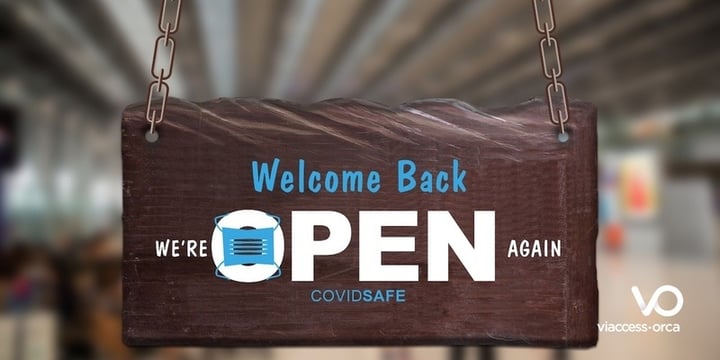Over a year from the first lockdowns, parts of the world are starting to emerge from the pandemic. With tradeshows on the horizon, what is the next normal going to be like?
 Few things in modern history have altered the world in the way that the Covid-19 pandemic has. For the broadcast industry in particular, the past year has been a time of huge change. It has had to scale to meet audience demands, work out how to make content remotely, cope with a pivot in advertising from traditional to targeted, and learn to do business differently.
Few things in modern history have altered the world in the way that the Covid-19 pandemic has. For the broadcast industry in particular, the past year has been a time of huge change. It has had to scale to meet audience demands, work out how to make content remotely, cope with a pivot in advertising from traditional to targeted, and learn to do business differently.
Almost a year ago we interviewed some of our top executives at VO on Challenges, Trust, and the Future of Work. As lockdowns now ease in a very patchy manner worldwide, most of the challenges we talked about then are still with us. We all still mostly work remotely, there are few if any face-to-face meetings, and relationships with colleagues and customers are still maintained by video.
So what will the rest of 2021 bring? As vaccine programs accelerate and we start to return to normality, what elements of the past year will remain with us? What have been the good ideas worth retaining from a year in lockdown? And what is coming up?
2021: the return of physical tradeshows?
One of the biggest adjustments the industry had to make during 2020 was the absence of physical tradeshows. These are planning on coming back this year, though the dates of many have changed, they have mainly compacted down to three days, and the additional biosecurity measures that have been put in place for some are impressive.
MWC 2021, which has a comparatively early date of 28 June, probably best illustrates the extent to which shows can go. Its Check-In To Get In program details a whole range of measures from the rollout of facial recognition technology to ensure touchless contacts, a requirement for a negative rapid test result within a 72-hour window, the compulsory filling in of a daily health questionnaire, the wearing of FFP2 masks, and more. Additional requirements for travel into Spain have also been put in place by the Spanish authorities.
So, what do we know about the more broadcast-specific tradeshows that are coming up this year? This is the status of the three major ones (correct as of April 12, 2021).
Broadcast Asia — 14-16 July, Singapore. Pushed back a month to July, BCA has joined forces with a new flagship tech event, Asia Tech x Singapore. It has also switched to becoming an invitation-only event for this year that is reliant on pre-scheduled meetings rather than walk-by and footfall.
IBC2021 — 3-6 December, Amsterdam. Hedged its bets by initially announcing both a September and a December date before deciding on the December one in late May. "We did not decide to move from September lightly," commented IBC CEO, Mike Crimp. "As the evidence was gathered and considered, there was a shifting sentiment towards December from both exhibitors and visitors. Only one in ten (11%) of the visitors surveyed said they would not attend a December event, which tells us that there’s an appetite for the industry to get back to doing business face-to-face as soon as it is safe to do so."
NAB 2021 — 9-13 October, Las Vegas. Most extreme calendar change of all from the original April date. Coming a month after IBC, there is a widespread belief that both will become more regional shows than usual as a result, concentrating on Europe and the Americas respectively. Organizers currently hope that NAB 2021 will be 80 to 90% of the usual size.
To date, most of the smaller shows and conferences that pepper the calendar between the big events have decided to remain virtual so far. That might change as we move towards the autumn, depending on the efficacy of vaccine rollouts, the return of international travel, etc.
One thing we can say about the major shows this year is that they will feel different. In all likelihood, attendance will be down, which will be a good thing as social distancing measures are likely to be strictly adhered to (IBC is planning on a strict 1.5 metre rule). This will make meetings and demos a challenge, but not an insurmountable one, with some companies looking at being able to show demos on mobile devices rather than have crowds stand round a screen, for stance. Face masks will be mandatory in all public spaces, with thermal scanning at the entrances and directions to rapid Covid testing facilities in case of temperature spikes planned. All attendees will likely have to digitally sign a waiver every day attesting that they are free of Covid symptoms as well.
Given the hoops that need to be jumped through, it is unsurprising that there is a new emphasis on hybrid models from all shows that mix both the physical and the virtual for those who do not wish to physically attend.
Doing business in a pandemic
Sales teams, in particular, are looking forward to the resumption of tradeshows, as the normal routine of face-to-face meetings has been enormously disrupted by the pandemic.
"We have regular (daily) contacts between our team, and also with our contacts from the industry, partners, prospects, and customers regularly,” commented VO’s Arnaud Alvarez, Executive VP, Global Sales, last year. “This is definitively one of the keys to being stronger when this crisis is over.”
Of course, the situation has gone on longer than many people expected it would, so such contacts have only gained importance in recent months. It will be interesting to see if these are maintained once the tradeshow cycle gets back into full gear again too. Many sales teams have gone from the ‘peaks and troughs’ approach of seeing customers primarily face to face in Vegas or Amsterdam, to one of maintaining far more regular contact. Most companies, us included, have found this beneficial.
In many ways, the industry was also lucky that it had already moved to virtualized solutions. Upgrades to old-fashioned legacy systems with hardware swaps etc. would have been very difficult to schedule during certain national lockdowns. The fact that so many systems are now software-only and delivered via the cloud has made implementing new solutions and deployments challenging yet possible. Indeed, at VO we have not stopped helping broadcasters launch new services at any point during the pandemic.
The next normal?
So, how much of this will we carry forward into the future. What will the next normal look like?
The old saying is that if you do something 20 times it becomes a habit. In over a year of lockdown, we’ve certainly talked to people via video more than 20 times rather than having a face-to-face meeting, and it’s easy to see this continuing. It’s been proved that entire companies can work from home and business can still be done, and many companies are going to want to maintain that flexibility moving forward. While for some, the erosion of boundaries between home life and work life has been difficult in the extreme, the hybrid approach is popular with the majority. The key lies in letting the employees have a choice. Inarguably though the decline in business travel has been beneficial for the environment.
That said, even though most of us can work and operate businesses remotely, a certain level of ‘human touch’ is still preferred and has been very much missed by many people. It has definitely, for example, made onboarding new recruits a challenge for everyone involved.
Covid has changed the way we do business. It has also handed us an opportunity to re-engineer it to be more efficient and inclusive too. Hopefully we’ll be able to take the best of both worlds and maintain the positive progresses that we have seen, especially in terms of technology and flexibility, amidst the negative nature of the global outbreak and the sad realities it created across the globe.
We have new hybrid models of work and they will soon be joined by new hybrid tradeshows. This is the next normal. But, whether our conversations happen in Amsterdam, Las Vegas, or simply at the screen where you read this, we look forward to talking to you again soon.
